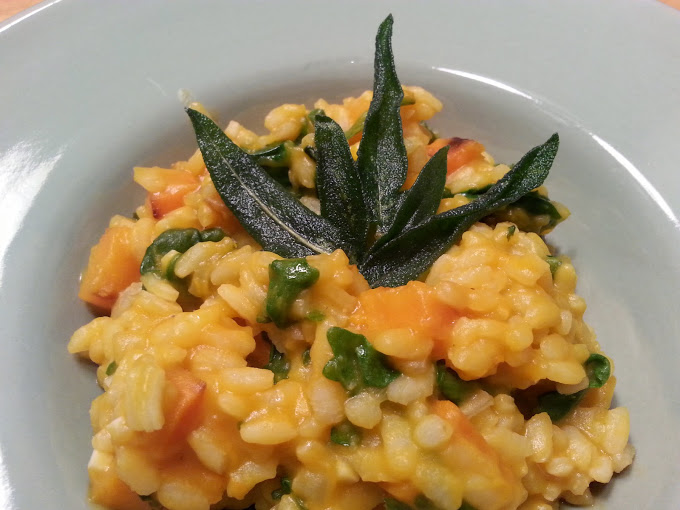Have you ever made risotto before? Traditionally risotto is known as a delicious and creamy rice that’s prepared differently from the standard method most of us use to make rice. However, risotto is actually a cooking method that can be applied to other grains as well.
To make a basic traditional risotto, you typically start with a short-grain Italian rice such as Arborio rice, sweat or sauté finely-diced onions and garlic in butter or oil, add the dry, unrinsed rice to toast in the butter or oil by stirring for a few minutes, then add water, potato water, stock, or wine, about a cup at a time, stirring until each cup is absorbed before adding the next, until the risotto is al dente or reaches the texture you like.
While short-grain Italian rice is typically used for risotto, you can use the risotto method to cook short-grain brown rice as well as other grains. As with the regular method for cooking rice, the risotto method takes longer for brown rice. Note that the risotto method does not work for long-grain rice such as jasmine or basmati because they are not starchy enough.
You can create all kinds of different flavors using the risotto method, and this is where it gets fun! You can start by adding other finely-diced veggies to the onions and garlic such as red, yellow, or green bell peppers, celery, carrots, or zucchini to sweat or sauté before toasting the rice.
You can get flavorful with the liquid by substituting a puree, juice, or sauce for part of the liquid. For example, you can add 1-2 cups of: your favorite pasta sauce; pureed cooked vegetables such as butternut squash, asparagus, or eggplant; coconut milk; or even juice to make a sweeter risotto.
You can add even more flavor by folding in seasonings, roasted vegetables, or even some flavored oil after the rice is finished cooking. Use your imagination and you can come up with all kinds of fun ways to enjoy risotto!
I made the risotto shown here with butternut squash and sage, and it was incredible! I started by sweating finely-diced onion and garlic, then toasting the rice. I prepared a puree of butternut squash by cooking half of a butternut squash (diced into ¾” cubes) with fresh garlic in boiling water until tender, then pureeing the butternut squash and garlic in the blender
I added 2 cups of the puree, one at a time, until completely absorbed, then continued to add water, one cup at a time until the rice was al dente. Meanwhile, I roasted the other half of the butternut squash (diced into ½” cubes) and added those along with 2 cups of arugula when the rice was done cooking. I topped it with fresh sage leaves fried in grape seed oil and a drizzle of sage-infused brown vegan butter. Yum!!!
What is your favorite way to prepare risotto? Please leave a comment!
To make a basic traditional risotto, you typically start with a short-grain Italian rice such as Arborio rice, sweat or sauté finely-diced onions and garlic in butter or oil, add the dry, unrinsed rice to toast in the butter or oil by stirring for a few minutes, then add water, potato water, stock, or wine, about a cup at a time, stirring until each cup is absorbed before adding the next, until the risotto is al dente or reaches the texture you like.
While short-grain Italian rice is typically used for risotto, you can use the risotto method to cook short-grain brown rice as well as other grains. As with the regular method for cooking rice, the risotto method takes longer for brown rice. Note that the risotto method does not work for long-grain rice such as jasmine or basmati because they are not starchy enough.
You can create all kinds of different flavors using the risotto method, and this is where it gets fun! You can start by adding other finely-diced veggies to the onions and garlic such as red, yellow, or green bell peppers, celery, carrots, or zucchini to sweat or sauté before toasting the rice.
You can get flavorful with the liquid by substituting a puree, juice, or sauce for part of the liquid. For example, you can add 1-2 cups of: your favorite pasta sauce; pureed cooked vegetables such as butternut squash, asparagus, or eggplant; coconut milk; or even juice to make a sweeter risotto.
You can add even more flavor by folding in seasonings, roasted vegetables, or even some flavored oil after the rice is finished cooking. Use your imagination and you can come up with all kinds of fun ways to enjoy risotto!
I made the risotto shown here with butternut squash and sage, and it was incredible! I started by sweating finely-diced onion and garlic, then toasting the rice. I prepared a puree of butternut squash by cooking half of a butternut squash (diced into ¾” cubes) with fresh garlic in boiling water until tender, then pureeing the butternut squash and garlic in the blender
I added 2 cups of the puree, one at a time, until completely absorbed, then continued to add water, one cup at a time until the rice was al dente. Meanwhile, I roasted the other half of the butternut squash (diced into ½” cubes) and added those along with 2 cups of arugula when the rice was done cooking. I topped it with fresh sage leaves fried in grape seed oil and a drizzle of sage-infused brown vegan butter. Yum!!!
What is your favorite way to prepare risotto? Please leave a comment!




 RSS Feed
RSS Feed